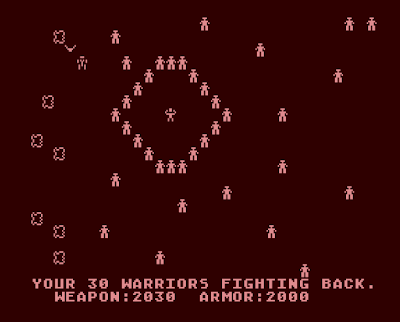From The CRPG Addict
 |
| Does that mean Guinevere is real?! Or have I just carried a robot out of the park? |
Fantasyland 2041
United States
Crystalware (developer and original publisher); Epyx (later publisher)
Released in 1981 for Apple II and Atari 800
Date Started: 9 October 2019
Date Finished: 19 October 2019
Total Hours: 9
Difficulty: Hard (4/5)
Final Rating: (to come later)
Ranking at time of posting: (to come later)
Summary:
Fantasyland 2041 is an epic adventure on non-epic hardware: a long, difficult game with primitive graphics and mechanics. Set in a Westworld-like future of holograms and animatronics, guests proceed through a series of adventure scenarios–Congoland, Arabian Adventure, King Arthur, Olympus, Captain Nemo, and Dante’s Inferno–and back again. Along the way, they must find certain items to rescue Lancelot or Guinevere from hell. They must also manage food and inventory, fight hostile parties, and solve a few light inventory puzzles. The interface is top-down, which often conflicts mentally with what looks like first-person graphics. The game’s scope and intent are admirable, but ultimately it’s too annoying and boring for the graphics, sound, and mechanical complexity of the era.
******
The manual to Fantasyland 2041 takes pains to emphasize the length and difficulty of the adventure.
[Y[ou may conclude that it is impossible to ever finish or win this game. We had to make it pretty tough. The average adventurer will probably never see the Throne of Lucifer or make it past the gates to the Underworld. We hope that just the experience of a single adventure will be sufficiently entertaining to satisfy our most critical hobbyists.
I can sympathize. Players expected, as they do now, to get a certain amount of playing time out of a $40.00 purchase. Arcade games satisfied that time minimum by being repeatable, but for adventure games and RPGs, a lot of the mystery was gone after you won for the first time. Thus, the developer had to prolong that time. Eventually, they would do that with bigger worlds and more game detail, but those weren’t options in the early years of the microcomputer. (Less because of technology and more because of a lack of innovative templates.) So instead, they prolonged the games by just making them hard. Permadeath was a common solution. Fantasyland goes a different direction by allowing you to save anywhere but almost always rolling the dice against you.
There’s a seed of a good game in Fantasyland 2041, and part of me wishes John Bell had waited several years and then developed it under the influence of, say, the Ultima series. I would have like to experience it with more complex commands, more thoughtful puzzles, interesting NPCs, and tactical combat. Instead, game design is as primitive as the world it inhabits, involving a lot of trial and error before the player learns enough to make a successful winning run.
As we covered in the first entry, exploring the land is a very linear process. The Hall of Heroes leads to Congoland, which leads to the Arabian Adventure, which leads to King Arthur. These first three lands are all quite similar.
- Each one has individual enemies visible on-screen who chase you around the map and attack you. In Congoland, these are tigers and gorillas. In the Arabian Adventure, they’re samurai. In King Arthur, they’re Modred and the Black Knight.
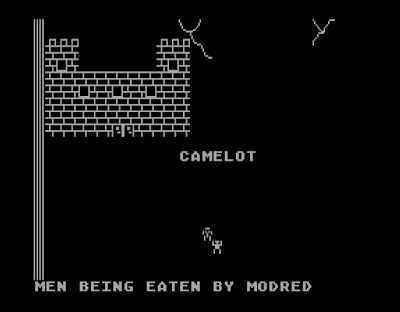 |
| I’m not sure I remember this part of Le Morte D’Arthur. |
- Each has packs of enemies who can attack randomly at any moment (while you’re standing still or moving) but are not seen on-screen. Across the three lands, these progressed from headhunters and Zulu warriors to Turks and scorpions to knights and archers.
- Each has physical features that are dangerous to bump into, running the risk of losing equipment or companions. These include swamps, logs, mountain crevices, fallen logs, and cliffs.
- Each has random environmental effects (earthquakes, sandstorms) that have the same effect.
- Each has treasure chests to find and loot, and villages where you can buy and sell goods and companions.
- Each has a special spellcasting enemy–witch doctors, genies, and sorcerers–who are necessary to have in your party to “solve” the area.
- Each culminates at a door to the next world, where you must use the magic of one of your spellcasters to progress.
Each land is made of blocks of roughly 8 x 8. It’s tough to count exactly because the screens continually scroll. Each block can have a particular type of terrain. The manual organizes these blocks into named sections (“Jungles,” “the Desert,” “Baghdad,” “Stonehenge”) and gives you clues about what you need to accomplish there.
King Arthur’s world changed the rules a bit by allowing parties of knights and archers to join you when you (G)reet them rather than attack. This sounds like a good idea, but the most difficult feature of the game is keeping all your companions fed. You can only carry a maximum of 255 of any item, including rations, and every companion eats a meal roughly two game minutes. If you somehow get 100 companions in your party, you have at most about five minutes before they start to starve to You can barely move between all the death notices and the need to constantly stop and drop equipment, so once characters start starving, it’s basically a reload.
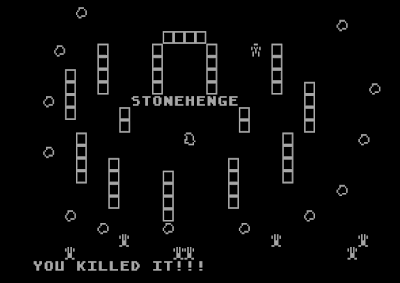 |
| I don’t remember why this was here. |
Thus, resource issues discourage you from developing a large party, particularly since enemy parties just scale to your size anyway. However, the “individual” enemies on each map–Modred and the Black Knight on King Arthur’s map–all have high strength and need a large party to successfully counter, particularly if you want to minimize the chance that they’ll kill your spellcasters. Thus, you have to find the balance between logistical annoyance and combat effectiveness.
King Arthur’s realm features a dragon’s lair, with the dragon guarding the sword Excalibur. The dragon has 50,000 strength, which can only be countered by a very large party. To defeat the dragon, I hung out near his lair, let hundreds of companions join me, killed him, grabbed Excalibur, and then dropped the companions. Having Excalibur among my equipment made the rest of the game a lot easier.
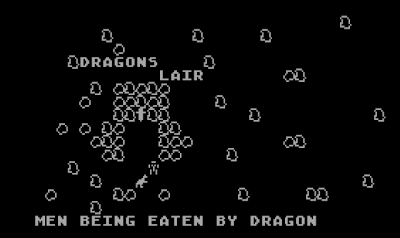 |
| Fighting a dragon to get Excalibur. |
There’s also a second artifact to find in King Arthur’s territory: a Ring of Power. The manual makes a big deal about the importance of Rings of Power, but I only ever found two, and as far as I could tell, they just sat in my inventory. I never employed them. Also in King Arthur’s realm: Holy Grails (plural!) show up in treasure chests and can be sold for a lot of money.
King Arthur’s world culminates in Merlin’s Labyrinth, another maze. Getting past Merlin involves using one of the magic items you’ve acquired from the witch doctor, sorcerer, or genie. Once he’s gone, you can progress to Olympus.
I’ll pause here to note that (U)sing items is one of the more annoying parts of the game. Every time you hit the command, you have to scroll through multiple inventory pages before you get to the place you enter the item’s number. Since the “B” key also scrolls through inventory, the developers should have had “U” just take you right to the number, in case you already remembered it. A lot of items, like scrolls, feel like they should be useable but are not.
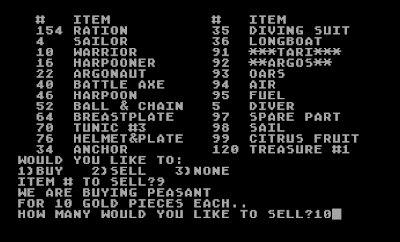 |
| Inventory eventually gets very unwieldy. |
The Olympus level changes the rules. You begin at Olympus itself, a town where you can buy and sell goods. You must buy the ship Argos, which appears off the “coast” to the west. To get to the ship, you have to buy a longboat and (U)se it at the edge of the Olympus screen. Once you’re on the Argos, you need a sail, an anchor, and oars to operate it. You have to (U)se the anchor to lift it, and after that you can either row with oars, which allows you to go any direction but consumes more food, or sail with the winds, which is a little harder to master.
 |
| Sailing away from Olympus. |
The level is populated with numerous islands. I couldn’t figure out how to land on the Isle of Delos to the west. A northwest island had the Cyclops, who carried 2,000 gold pieces. A northeast island had the sorceress Circe, who carried the second Ring of Power. Finally, an eastern island, Thera, had the portal to the next land. I should mention that we get the only complex sound on this level, with a cycling shhhhh suggesting waves.
 |
| The Argos waits offshore while the party picks up the Ring of Power from the slain Circe. |
There was a lot of inventory shuffling because to enter Captain Nemo’s world, you need a submarine, which you can purchase in Olympus, but it’s enormously heavy, so you need people without equipment to bear the weight. Once you choose to enter the submarine, however, your companion and inventory maximums drop precipitously, and you have to jettison a lot of people and stuff.
 |
| Handling logistics for boarding the submarine. |
Captain Nemo’s world is all underwater, and running the submarine into any object causes it to fall apart. I think you can fix it with “spare parts,” but I had neglected to purchase any of these, so any time I accidentally rammed into a coral reef, I had to reload. There are treasure chests that you can send divers with diving suits out to retrieve, but only at certain depths. I found the whole level frustrating and thus wasn’t unhappy when I found Atlantis in the northwest corner and immediately transitioned to the final level.
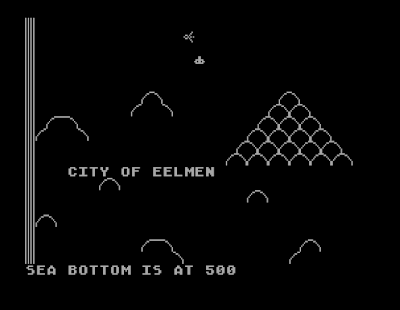 |
| I never figured out anything to do in the City of Eelmen. |
Dante’s Inferno takes place among brimstone pits and rows of demons who just stand there until you run into them, at which point they kill your companions. The City of Dis in the northwest is the first place to buy and sell equipment and companions since Olympus. Demons and Nosferatu attack as you explore, although I found that around a dozen knights plus Excalibur made short work of them.
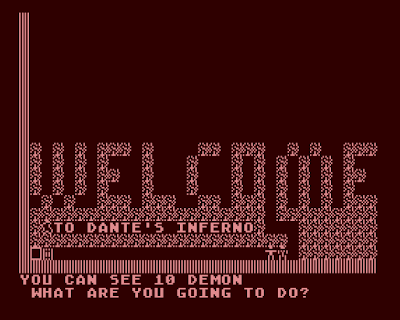 |
| At least they make me feel “welcome.” |
Rivers of fire funnel you to the north, where you have to use a plank (sold in Dis) to cross an abyss. Finally, in the northwest corner, you find Lancelot or Guinevere being guarded by Lucifer. As long as you have the two Rings of Power and a Signet Ring from Camelot (the manual warns you to buy it), he or she will come along with you immediately.
 |
| All I did was walk up to him. This felt anti-climactic. |
At that point–much to my furor–you have to reverse your steps and make your way all the way back to the beginning, traversing each of the lands in reverse order. That took longer than it should have because I had gotten rid of a lot of the items needed for the ship and submarine, thinking I wouldn’t need them again.
Returning to the entrance gives you a brief message that “You made it back with Guinevere” and then a “Final Score” screen that summarizes your wealth, experience, and time. The screen encouraged early players to send their disks to Crystalware for a chance to win $1000, with the winner chosen from the highest scorer to solve the game before 1 December 1981.
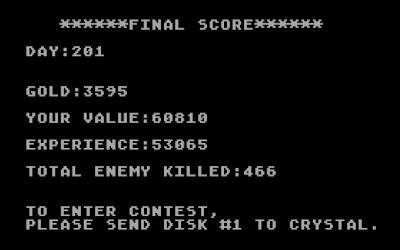 |
| 201 days?! How do people take that much time off work in the future? |
One outstanding mystery concerns, well, “The Great Mystery.” This is what the manual has to say about it:
To win the prize, you must solve the Great Mystery and beat out your competitors in treasure and courage . . . The mystery is unlike any of the others. It is not an anagram nor is it found anywhere on the disk in basic or machine language . . . At the end of the game, if you make it, you will be prompted to send your disk in if you wish to enter the contest. Do not try to make a copy to send in; it must be the original. At our plant, we have a huge score board, with a list of all the fantasylanders and their achievements. The person to solve the mystery and score the highest will be awarded a trophy and receive $1,000 in cash.
So there’s supposedly some Great Mystery that you have to solve to win the prize–but it’s not the same thing as winning the game by finding Lancelot or Guinevere, which you presumably have to do, too. More important, the instructions only mention sending in the disk. How will the developers know that someone has solved the Great Mystery, too? Is it somehow recorded on the disk? Did they assume players would know enough to include a separate note? What did they mean when they say the mystery “is unlike any of the others”? Any of the other what?
A re-read of the manual produces few clues. There are poems that suggest using the rings or perhaps scrolls on the “666” of King Solomon’s Temple, but nothing I try works. Messages just tell me that those items are “already in use.” I’ve inspected the disks, and I can’t find any text related to a bigger mystery, but then again the manual itself warned me that wouldn’t work.
Fantasyland 2041 isn’t much of an RPG. It lacks any character development (I don’t think the “experience” statistic does anything for you during the game) or personal inventory, and combat is as simple as a game of War. I give it an 18 on the GIMLET, with the best scores (3s) in coencounters and inventory. I still don’t know the purpose of half the stuff you can pick up. I don’t believe I ever used a rope, a shovel, a spotlight, citrus fruit (I assume it was there to stave of scurvy, but no one ever ate it), quinine, a compass, a magic carpet, a box of sand, mushrooms, a lute, squid ink, a wooden stake, or half a dozen other items that didn’t seem to be weapons, armor, or treasure.
We also leave the game with some out-of-game mysteries as well. Why did John Bell announce in the manual that this would be his last great fantasy? What happened to him and Patricia Bell after 1982, when the last Crystalware title was published? How did it morph into Crystalware Defense and Nanotechnology of the 2010s, and what did Bell do in the meantime?
I’ve been exposed to three Crystalware games at this point, and all of them are similar in their interfaces, mechanics, and suggestions that something deeper is happening beneath the game’s surface. I have four more on my list and will probably be a bit less forgiving about their statuses as RPGs under my rules. Nonetheless, it was fun to see another example of a developer who, in the area of five-and-a-quarter-inch floppy disks, dared to dream big.
Original URL: http://crpgaddict.blogspot.com/2019/10/fantasyland-2041-won-with-summary-and.html


